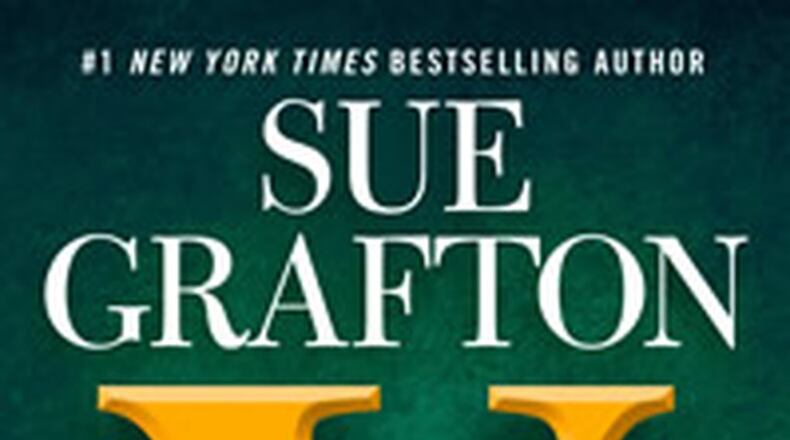But for Sue and Kinsey fans, the alphabet now ends at Y — with “Y is for Yesterday,” which was published August 2017.
To say Sue’s work was ground-breaking is not an overstatement. The female detectives created by Sue, and her writing peers Marcia Muller and Sara Paretsky, defied the expectations of female characters as sidekicks, paramours or femme fatales. These writers empowered a new wave of female mystery writers and female protagonists with their own sense of agency.
On a more personal level, I consider Sue Grafton an important mentor for me as a writer, teacher and literary citizen. As a three-time instructor at Antioch Writers’ Workshop at University of Dayton — twice as a keynoter — Sue had a strong impact on writers in our area and beyond.
In 1990 I saw an ad in Writer’s Digest for the Antioch Writers’ Workshop. The instructor for the morning class in fiction was Sue Grafton, who by then was on “G is for Gumshoe.” I couldn’t believe it; I so admired her work. I immediately signed up.
READ THIS NEXT: Multiple Oregon District businesses to be closed for months after destructive fire; owners vow to return
Though everyone turned out to be welcoming, it was Sue who gave me the courage, inspiration and practical tool kit to help me become a published novelist. Her blend of love — yes, love — for the craft of writing, along with a fierce belief in the discipline that a writing career requires, resonated with me. “DO THE WORK” became the mantra of the week.
I can see her now, drawing across the classroom’s board a long line representing the five years from the moment a writer starts learning the craft to the moment one might, at the earliest, expect to have written a novel worthy of publication. I can hear her saying that it takes five years to become a skilled lawyer or doctor or professor, so why wouldn’t we respect the craft of writing to that same level?
Another writer at the 1990 workshop was Kathy Trocheck. We were roommates, and became writing buddies. Kathy’s published many mysteries, and has gone on to write best-selling novels under the pen name Mary Kay Andrews. She, too, credits Sue with providing us with the tool kit we needed to approach writing as a craft and a career.
That week, I met with Sue for a one-on-one review of the opening pages of my first mystery novel, which I’d spent three years writing. According to my notes, Sue’s comments were, “Your dialogue is as unrealistic as that on a soap opera. You haven’t done your research and it shows in your descriptions of crime scenes. But you can plot. And you have a good imagination. I think that someday you can be published.”
Those comments were pure gold. By giving me a critique that both affirmed what I was doing well and provided specific areas to improve, Sue not only helped me with my manuscript, but taught me how to teach. I went home and studied everything I could about dialogue. And I became a thorough researcher.
I put away that first novel and, applying all I’d learned from writing it and from Sue, wrote my next one, “Angel’s Bidding.” It was accepted for publication by Fawcett Books — five years after I committed to learning the craft of creative writing. Sue provided a glowing blurb to grace its cover.
Zac Efron movie about serial killer Ted Bundy filming locally looking for extras
At the 1994 Bouchercon, a huge annual mystery conference, I walked into a dinner not knowing anyone, but heard someone call my name. It was Sue. She gestured me over to her table, introduced me around, and beamed as she said, “This is one of my students … and she made it over the line!”
After my first mystery series ended, I sent Sue an email expressing my frustration with my then-agent. (For the record, I respect and trust my current agent!) She called me, talked me out of my panic, told me that I needed to “own” what I want out of my writing career, to ask for help in getting to those goals, to both “set high aspirations but let go of expectations.” And with her classic humor and practicality, she told me, “Don’t forget to pee before any big conversation. That’s important, too!”
Sue returned to Antioch Writers’ Workshop in 1995 and 2005 as keynoter, again translating her experiences — now as an international literary star — into advice and lessons that applied to us wherever we were on the writing path.
The last time I saw her was at a book fair in 2013, where she was a headliner and I was one of many authors. My non-mystery, “My One Square Inch of Alaska,” had been published, and I messaged Sue that I’d be there. We chatted briefly about lunch or dinner possibilities. In the end, Sue’s schedule precluded getting together.
Yet a few hours into the book fair, Sue walked down my row, seemingly not noticing the murmurs of awe, and bee-lined to my table. She swooped me into a warm hug, congratulated me on my latest title, and said with her characteristic twinkle — a mix of intelligence and warmth and humor — that “we gals” need to stick together on the writing journey.
To me, Sue Grafton was a favorite author, but she was also mentor. Inspiring and practical, wise and witty, tough and kind — a bright thread running through my writing life.
I can only aspire to live up to the example she lived. If I get a tenth of the way there, I’ll be doing well.
And I hope that she would smile at me ending this column by borrowing the characteristic final phrase of her Kinsey novels:
Respectfully submitted,
Sharon
About the Author
